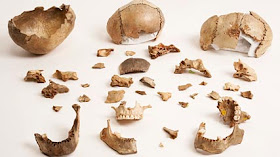 |
| Photo by Darren England, news.com.au |
Mr. Jackson had trained dogs to find all sorts of things such as koala bears and cane toads, and he got the idea that maybe a dog could learn to find ancient human bones, which would help archeologists a whole lot with their work.
Migaloo's name means "white fellow" in the Aboriginal language. It's kind of like a joke because Migaloo is not white at all! The Aboriginal elders told Mr. Jackson it was okay to train Migaloo by using some bones of their ancestors that were in the South Australian Museum. Mr. Jackson taught Migaloo that she only got to play with her ball when she found a bone. After about 6 months of training, she was totally obsessed with finding bones so that she could play ball.
 |
| news-mail.com.au |
When Migaloo finds a bone, she focuses on that spot and acts very excited. Then Mr. Jackson says "show me," and Migaloo puts her nose on the ground and starts moonwalking backwards from the spot where she smelled the bone.
 |
| An ancient burial site with ancient bones in it |
Migaloo has proved that she can find a buried bone as small as the size of a fingernail from a distance of 10 feet or so. The big test the trainers did with her was at an Aboriginal burial ground in South Australia, where a 600-year-old grave had been found a few years before. The Aboriginal elders knew where the graves were, but the trainers didn't. Within two minutes, Migaloo started circling the spot where the oldest grave was. She could smell it even though it was almost 2 meters underground.
 |
| Photo by Darren England, news.com.au |
Migaloo can do all this stuff because she is a dog, and dogs have a super-excellent sense of smell, like I have told you several times before. Cadaver dogs sniff for rotting flesh, but Migaloo is just smelling the dry, bare bones because they are so very old that there is no flesh left on them.
As soon as Migaloo makes a find, Mr. Jackson gives her the ball, and that way she doesn't dig the bones up or hurt them in any way. Personally, I don't think she would even want to chew on the bones because they are so old that they would not taste very good. And you might break a tooth if you chewed on something that hard and dry.
 |
| Natural History Museum, London |
Mr. Jackson hopes that lots of other dogs will soon be trained to find old bones like Migaloo does. There are many useful things that dogs like this could do, such as sniffing out people who got murdered, including maybe Jimmy Hoffa. Or they might find the ancestral graves of native peoples, so then those graves wouldn't get dug up by people building parking lots or whatever. Also there were soldiers who died during some of the wars in the past, and nobody knows where their bodies ended up. Trained dogs could help find these people, too, and then the people could be buried properly in a real cemetery.
 |
| Photo from Gary Jackson National Geographic Magazine |
Before Migaloo found the 600-year-old grave, the oldest grave that any dog ever found was an 1812 grave from the Battle of Snake Hill in Ontario. The bones in that grave were 175 years old, and they were found by a cadaver dog named Candy. Now Migaloo has beaten that record by 425 years, which is pretty darned good, if you ask me.
No comments:
Post a Comment